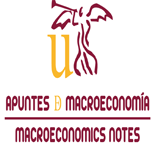
So far we have seen the goods market and the money market as two markets that operate separately, without being able to interact with each other. However, these markets can influence each other, affecting their equilibrium situations.
The goods market is in equilibrium when DA is equal to the level of income in the economy (DA=Y). The money market is in equilibrium when the demand for money is equal to the money supply in real terms (L=M/P).
How can one market influence the other? We have seen that the demand for money depends on income (L=kY-hi). Thus, the equilibrium income of the goods market affects the money demand, and therefore the monetary equilibrium.
On the other hand, the equilibrium of the money market determines the market interest rate. This interest rate affects investment, which is a component of DA. Therefore, money market equilibrium can affect DA and goods market equilibrium.